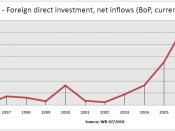Introduction
Slovakia has recently taken significant steps to improve its business environment, and companies such as BASF Chemical, which has decided to move some of its administrative offices from Vienna and Prague to Bratislava to take advantage of lower costs, have taken notice. But the Czech Republic remains the more competitive country, and it even has plans to lower its tax rate to further strengthen its position.
Body
Sound macroeconomic policy, assertive product, capital and labour market liberalisation, and fundamental tax and welfare reform have transformed the Slovak business environment in recent years. Foreign direct investment (FDI) has responded particularly well, becoming the prime engine of capacity and productivity growth, and helping to put the economy on a strong and well balanced growth path. Slovakia's economy has for the past several years been weaker than the Czech Republic's. In 1999 Slovakia's gross domestic product (GDP) was $20.4 billion (530.4
billion Kc) in adjusted terms compared with $55 billion here, and foreign investment was nearly one-twentieth the volume, according to The World Bank's World Development Indicators Database. Now both GDP and foreign investment are growing, and much of the improvement is owed to Slovakia's efforts to make the country more business-friendly. In 2004 the Slovak government approved lowering corporate tax rates to 19 percent significantly lower than the Czech Republic's 28 percent and decreased the amount of time required to register a business from up to two months to five days. The public sector has a critical role to play in providing the economy with a reliable legal and regulatory framework, and adequate core services. To do this better in the context of pressures for expenditure restraint, the government should make increased use of strategic priority setting and results-oriented budgeting. It should also accelerate the introduction of performance-based personnel management...


